Micro-Nano Carbon Structures with Platelet, Glassy and Tube-Like Morphologies
Abstract
:1. Introduction
2. Experiments
2.1. Exfoliation of FG into GNPs
2.2. Pyrolysis of GNPs/PF Mixture
2.3. Preparation of Multidimensional Carbon Structures with GNPs/GC/CNTs
2.4. Characterization
3. Results and Discussion
3.1. Effect of Carbon Contents and the Exfoliated Times on the Resultant GNPs
3.2. Phase and Microstructure of GNPs/GC Composites
3.3. Phase and Microstructure of GNPs/GC/CNT Composites
3.4. TG/DTA Results of PF, GNPs/PF, and GNPs/PF/Ni(NO3)2·6H2O
3.5. In Situ Growth Mechanism of CNTs through Ni(NO3)2·6H2O–Catalytic Pyrolysis of GNP/PF Mixture
4. Conclusions
- (1)
- The TRM method enabled the simple exfoliation of FG into micro/nano graphite platelets (GNPs) in high-viscosity PF. With an increasing exfoliation time, the sizes and thicknesses of the products decreased gradually. The micro/nano GNPs exhibited sizes of 10–30 μm and thicknesses of 30–50 nm when exfoliated 16 times.
- (2)
- After the GNPs/PF were pyrolyzed in an argon atmosphere at 1000 °C for 3 h, the GNPs were uniformly dispersed and closely embedded in the GC originating from the PF pyrolysis.
- (3)
- The Ni(NO3)2·6H2O played a key role in the formation and growth of CNTs converted from the catalytic pyrolysis of partial PF. The resultant multidimensional carbon nanostructures with GNPs/GC/CNTs were obtained, owing to the shear force of the TRM process, pyrolysis, and catalytic action of nitrates. These results provide a novel method for the production of inexpensive carbon precursors that can be applied in LCCRs.
Author Contributions
Funding
Conflicts of Interest
References
- Liu, Z.; Yu, J.; Yang, X.; Jin, E.; Yuan, L. Oxidation resistance and wetting behavior of MgO-C refractories: Effect of carbon content. Materials 2018, 11, 883. [Google Scholar] [CrossRef] [PubMed]
- Bag, M.; Adak, S.; Sarkar, R. Study on low carbon containing MgO-C refractory: Use of nano carbon. Ceram. Int. 2012, 38, 2339–2346. [Google Scholar] [CrossRef]
- Zhang, S.W. Next generation carbon-containing refractory composites. Adv. Sci. Technol. 2006, 45, 2246–2253. [Google Scholar] [CrossRef]
- Liao, N.; Li, Y.W.; Wang, Q.H.; Zhu, T.B.; Jin, S.L.; Sang, S.B.; Jia, D.C. Synergic effects of nano carbon sources on thermal shock resistance of Al2O3-C refractories. Ceram. Int. 2017, 43, 14380–14388. [Google Scholar] [CrossRef]
- Wang, Q.H.; Qi, F.S.; He, Z.; Li, Y.W.; Li, G.Q. Effect of graphite content and heating temperature on carbon pick-up of ultra-low-carbon steel from magnesia-carbon refractory using CFD modelling. Int. J. Heat Mass Transf. 2018, 120, 86–94. [Google Scholar] [CrossRef]
- Bag, M.; Adak, S.; Sarkar, R. Nano carbon containing MgO-C refractory: Effect of graphite content. Ceram. Int. 2012, 38, 4909–4914. [Google Scholar] [CrossRef]
- Behera, S.; Sarkar, R. Nano carbon containing low carbon magnesia carbon refractory: An overview. Prot. Met. Phys. Chem. 2016, 52, 467–474. [Google Scholar] [CrossRef]
- Zhu, T.B.; Li, Y.W.; Sang, S.B. Heightening mechanical properties and thermal shock resistance of low–carbon magnesia–graphite refractories through the catalytic formation of nanocarbons and ceramic bonding phases. J. Alloys Compd. 2019, 783, 990–1000. [Google Scholar] [CrossRef]
- Li, F.; Jiang, X.S.; Shao, Z.Y.; Zhu, D.G.; Luo, Z.P. Microstructure and mechanical properties of nano-carbon reinforced titanium matrix/hydroxyapatite biocomposites prepared by spark plasma sintering. Nanomaterials 2018, 8, 729. [Google Scholar] [CrossRef]
- Behera, S.; Sarkar, R. Study on variation of graphite content in N220 nanocarbon containing low carbon MgO–C refractory. Ironmak. Steelmak. 2016, 43, 130–136. [Google Scholar] [CrossRef]
- Liao, N.; Li, Y.W.; Jin, S.L.; Sang, S.B.; Harmuth, H. Enhanced mechanical performance of Al2O3-C refractories with nano carbon black and in-situ formed multi-walled carbon nanotubes (MWCNTs). J. Eur. Ceram. Soc. 2016, 36, 867–874. [Google Scholar] [CrossRef]
- Luo, M.; Li, Y.W.; Jin, S.L.; Sang, S.B.; Zhao, L.; Li, Y.B. Microstructures and mechanical properties of Al2O3-C refractories with addition of multi-walled carbon nanotubes. Mat. Sci. Eng. A 2012, 548, 134–141. [Google Scholar] [CrossRef]
- Liang, F.; Li, N.; Liu, B.K.; He, Z.Y. Processing and characterization of multi-walled carbon nanotubes containing alumina-carbon refractories prepared by nanocomposite powder technology. Metall. Mater. Trans. B 2016, 47, 1661–1668. [Google Scholar] [CrossRef]
- Bai, Y.X.; Zhang, R.F.; Ye, X.; Zhu, Z.X.; Xie, H.H.; Shen, B.Y.; Cai, D.L.; Liu, B.F.; Zhang, C.X.; Jia, Z.; et al. Carbon nanotube bundles with tensile strength over 80 GPa. Nat. Nanotechnol. 2018, 13, 589–595. [Google Scholar] [CrossRef] [PubMed]
- Rastegar, H.; Bavand, M.; Nemati, A.; Golestani, F. Phase and microstructural evolution of low carbon MgO-C refractories with addition of Fe-catalyzed phenol-formaldehyde resin. Ceram. Int. 2019, 45, 3390–3406. [Google Scholar] [CrossRef]
- Zhu, T.B.; Li, Y.W.; Jin, S.L.; Sang, S.B.; Liao, N. Catalytic formation of one-dimensional nanocarbon and MgO whiskers in low carbon MgO–C refractories. Ceram. Int. 2015, 41, 3541–3548. [Google Scholar] [CrossRef]
- Li, Y.W.; Shan, J.B.; Liao, N.; Sang, S.B.; Jia, D.C. Enhanced thermal shock resistance of low-carbon Al2O3-C refractories with direct CVD synthesis of nano carbon decorated oxides. J. Eur. Ceram. Soc. 2018, 38, 3379–3386. [Google Scholar] [CrossRef]
- Wang, Q.H.; Li, Y.W.; Luo, M.; Sang, S.B.; Zhu, T.B.; Zhao, L. Strengthening mechanism of graphene oxide nanosheets for Al2O3–C refractories. Ceram. Int. 2014, 40, 163–172. [Google Scholar] [CrossRef]
- Zhu, T.B.; Li, Y.W.; Luo, M.; Sang, S.B.; Wang, Q.H.; Zhao, L.; Li, Y.B.; Li, S.J. Microstructure and mechanical properties of MgO-C refractories containing graphite oxide nanosheets (GONs). Ceram. Int. 2013, 39, 3017–3025. [Google Scholar] [CrossRef]
- Zhang, B.X.; Cheng, L.F.; Lu, Y.C.; Zhang, Q. Scalable preparation of graphene reinforced zirconium diboride composites with strong dynamic response. Carbon 2018, 139, 1020–1026. [Google Scholar] [CrossRef]
- Zhu, T.B.; Li, Y.W.; Sang, S.B.; Xie, Z.P. A new approach to fabricate MgO-C refractories with high thermal shock resistance by adding artificial graphite. J. Eur. Ceram. Soc. 2018, 38, 2179–2185. [Google Scholar] [CrossRef]
- Zhao, W.F.; Fang, M.; Wu, F.R.; Wu, H.; Wang, L.W.; Chen, G.H. Preparation of graphene by exfoliation of graphite using wet ball milling. J. Mater. Chem. 2010, 20, 5817–5819. [Google Scholar] [CrossRef]
- Soares, O.S.; Rocha, R.P.; Gonçalves, A.G.; Figueiredo, J.L.; Órfão, J.J.; Pereira, M.F. Highly active N-doped carbon nanotubes prepared by an easy ball milling method for advanced oxidation processes. Appl. Catal. B Environ. 2016, 192, 296–303. [Google Scholar] [CrossRef]
- Du, P.; Wang, J.; Liu, G.Z.; Zhao, H.C.; Wang, L.P. Facile synthesis of intelligent nanocomposites as encapsulation for materials protection. Mater. Chem. Front. 2019, 3, 321–330. [Google Scholar] [CrossRef]
- Wang, H.L.; Lee, S.H.; Feng, L. HfB2–SiC composite prepared by reactive spark plasma sintering. Ceram. Int. 2014, 40, 11009–11013. [Google Scholar] [CrossRef]
- Zhu, Y.W.; Murali, S.; Stoller, M.D.; Velamakanni, A.; Piner, R.; Ruoff, R. Microwave assisted exfoliation and reduction of graphite oxide for ultracapacitors. Carbon 2010, 48, 2118–2122. [Google Scholar] [CrossRef]
- Munuera, J.M.; Paredes, J.I.; Enterria, M.; Pagan, A.; Villar, S.; Pereira, M.F.; Martins, J.I.; Figueiredo, J.L.; Cenis, J.L.; Martínez, A.; et al. Electrochemical exfoliation of graphite in aqueous sodium halide electrolytes toward low oxygen content graphene for energy and environmental applications. ACS Appl. Mater. Interfaces 2017, 9, 24085–24099. [Google Scholar] [CrossRef]
- Wu, W.J.; Liang, Y.H.; Ma, H.Y.; Peng, Y.; Yang, H.B. Insights into the conversion behavior of SiO-C hybrid with pre-treated graphite as anodes for Li-ion batteries. Electrochim. Acta 2016, 187, 473–479. [Google Scholar] [CrossRef]
- Ding, J.; Sun, J.M.; Huang, Z.X.; Wang, Y.B. Improved high-temperature mechanical property of carbon-phenolic composites by introducing titanium diboride particles. Compos. Part B Eng. 2019, 157, 289–294. [Google Scholar] [CrossRef]
- Li, Y.; Zhang, H.; Crespo, M.; Porwal, H.; Picot, O.; Santagiuliana, G.; Huang, Z.H.; Barbieri, E.; Pugno, N.M.; Peijs, T.; et al. In situ exfoliation of graphene in epoxy resins: A facile strategy to efficient and large scale graphene nanocomposites. ACS Appl. Mater. Interfaces 2016, 8, 24112–24122. [Google Scholar] [CrossRef]
- Yao, X.M.; Gao, X.Y.; Jiang, J.J.; Xu, C.M.; Deng, C.; Wang, J.B. Comparison of carbon nanotubes and graphene oxide coated carbon fiber for improving the interfacial properties of carbon fiber/epoxy composites. Compos. Part B Eng. 2018, 132, 170–177. [Google Scholar] [CrossRef]
- Zhao, Z.B.; Teng, K.Y.; Li, N.; Li, X.J.; Xu, Z.W.; Chen, L.; Niu, J.R.; Fu, H.J.; Zhao, L.H.; Liu, Y. Mechanical, thermal and interfacial performances of carbon fiber reinforced composites flavored by carbon nanotube in matrix/interface. Compos. Struct. 2017, 159, 761–772. [Google Scholar] [CrossRef]
- Wang, Y.R.; Wei, H.G.; Lu, Y.; Wei, S.Y.; Wujcik, E.K.; Guo, Z.H. Multifunctional carbon nanostructures for advanced energy storage applications. Nanomaterials 2015, 5, 755–777. [Google Scholar] [CrossRef] [PubMed]
- Zhu, B.Q.; Wei, G.P.; Li, X.C.; Ma, Z.J.; Wei, Y. Preparation and growth mechanism of carbon nanotubes via catalytic pyrolysis of phenol resin. Mater. Res. Innov. 2014, 18, 267–272. [Google Scholar] [CrossRef]
- Xiang, R.; Luo, G.; Qian, W.; Zhang, Q.; Wang, Y.; Wei, F.; Li, Q.; Cao, A.Y. Encapsulation, compensation, and substitution of catalyst particles during continuous growth of carbon nanotubes. Adv. Mater. 2007, 19, 2360–2363. [Google Scholar] [CrossRef]
- Patel, R.B.; Chou, T.; Kanwal, A.; Apigo, D.J.; Lefebvre, J.; Owens, F.; Zafar, I. Boron-filled hybrid carbon nanotubes. Sci. Rep. 2016, 6, 30495. [Google Scholar] [CrossRef] [PubMed]
- Urhan, B.K.; Demir, Ü. Electrochemical fabrication of Ni or Ni(OH)2@Ni nanoparticle-decorated reduced graphene oxide for supercapacitor applications. Electrochim. Acta 2019, 302, 109–118. [Google Scholar] [CrossRef]
- Kmita, A.; Benko, A.; Roczniak, A.; Frączek, A.; Holtzer, M. Pyrolysis of organic ester cured alkaline phenolic resin: Identification of products. J. Anal. Appl. Pyrol. 2018, 129, 6–12. [Google Scholar] [CrossRef]
- Han, F.D.; Bai, Y.J.; Liu, R.; Yao, B.; Qi, Y.X.; Lun, N.; Zhang, J.X. Template-free synthesis of interconnected hollow carbon nanospheres for high-performance anode material in lithium-ion batteries. Adv. Energy Mater. 2011, 1, 798–801. [Google Scholar] [CrossRef]
- Steirer, K.X.; Richards, R.E.; Sigdel, A.K.; Garcia, A.; Ndione, P.F.; Hammond, S.; Baker, D.; Ratcliff, E.L.; Curtis, C.; Furtak, T.; et al. Nickel oxide interlayer films from nickel formate–ethylenediamine precursor: Influence of annealing on thin film properties and photovoltaic device performance. J. Mater. Chem. A 2015, 3, 10949–10958. [Google Scholar] [CrossRef]
- Gohier, A.; Ewels, C.P.; Minea, T.M.; Djouadi, M.A. Carbon nanotube growth mechanism switches from tip-to base-growth with decreasing catalyst particle size. Carbon 2008, 46, 1331–1338. [Google Scholar] [CrossRef]
- Zhao, W.; BasnetIk, B.; Kim, I.J. Carbon nanotube formation using zeolite template and applications. J. Adv. Ceram. 2012, 3, 179–193. [Google Scholar] [CrossRef]
- Bajpai, R.; Wagner, H.D. Fast growth of carbon nanotubes using a microwave oven. Carbon 2015, 82, 327–336. [Google Scholar] [CrossRef]
- Ubnoske, S.M.; Radauscher, E.J.; Meshot, E.R.; Stoner, B.R. Integrating carbon nanotube forests into polysilicon MEMS: Growth kinetics, mechanisms, and adhesion. Carbon 2017, 113, 192–204. [Google Scholar] [CrossRef] [Green Version]
- Hu, Z.H.; Huang, J.T.; Luo, Y.; Liu, M.Q.; Li, X.B.; Yan, M.G.; Ye, Z.; Chen, Z.; Feng, Z.; Huang, S. Wrinkled Ni-doped Mo2C coating on carbon fiber paper: An advanced electrocatalyst prepared by molten-salt method for hydrogen evolution reaction. Electrochim. Acta 2019, 319, 293–301. [Google Scholar] [CrossRef]
- Kumar, M.; Ando, Y. Chemical vapor deposition of carbon nanotubes: A review on growth mechanism and mass production. J. Nanosci. Nanotechnol. 2010, 10, 3739–3758. [Google Scholar] [CrossRef] [PubMed]
- Shah, K.A.; Tali, B.A. Synthesis of carbon nanotubes by catalytic chemical vapour deposition: A review on carbon sources, catalysts and substrates. Mat. Sci. Semicond. Proc. 2016, 41, 67–82. [Google Scholar] [CrossRef]
- Lin, M.; Tan, J.P.; Boothroyd, C.; Loh, K.P.; Tok, E.S.; Foo, Y.L. Dynamical observation of bamboo-like carbon nanotube growth. Nano Lett. 2007, 7, 2234–2238. [Google Scholar] [CrossRef]
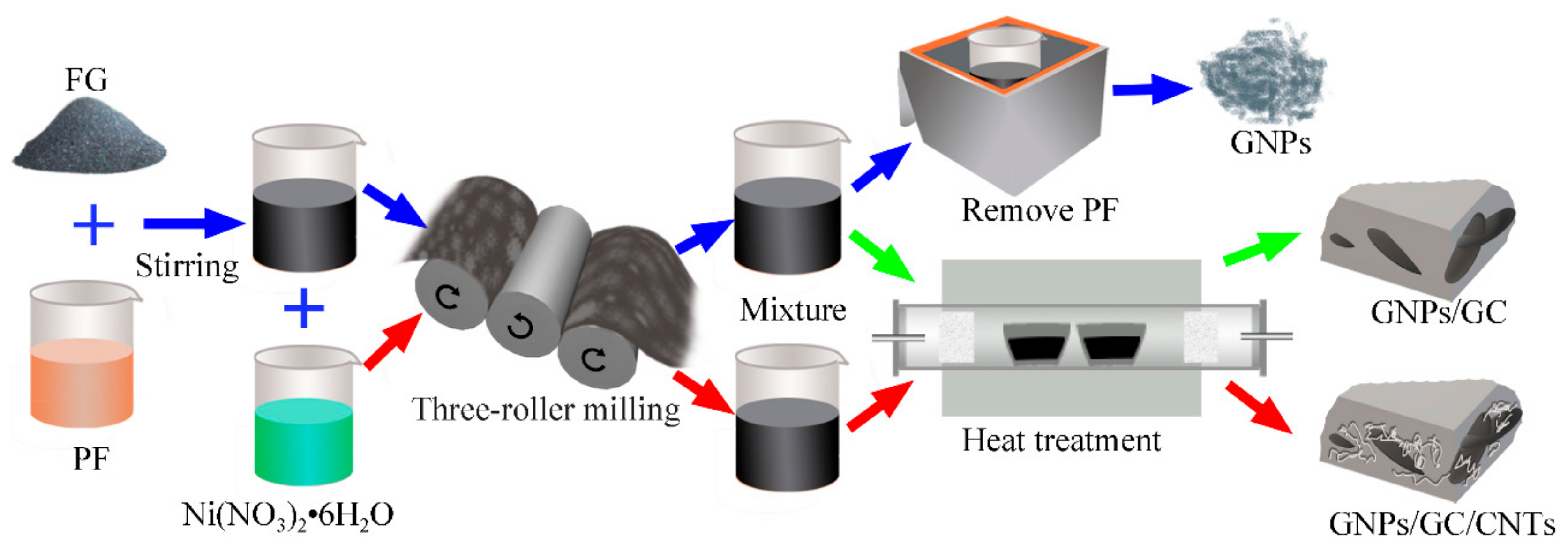
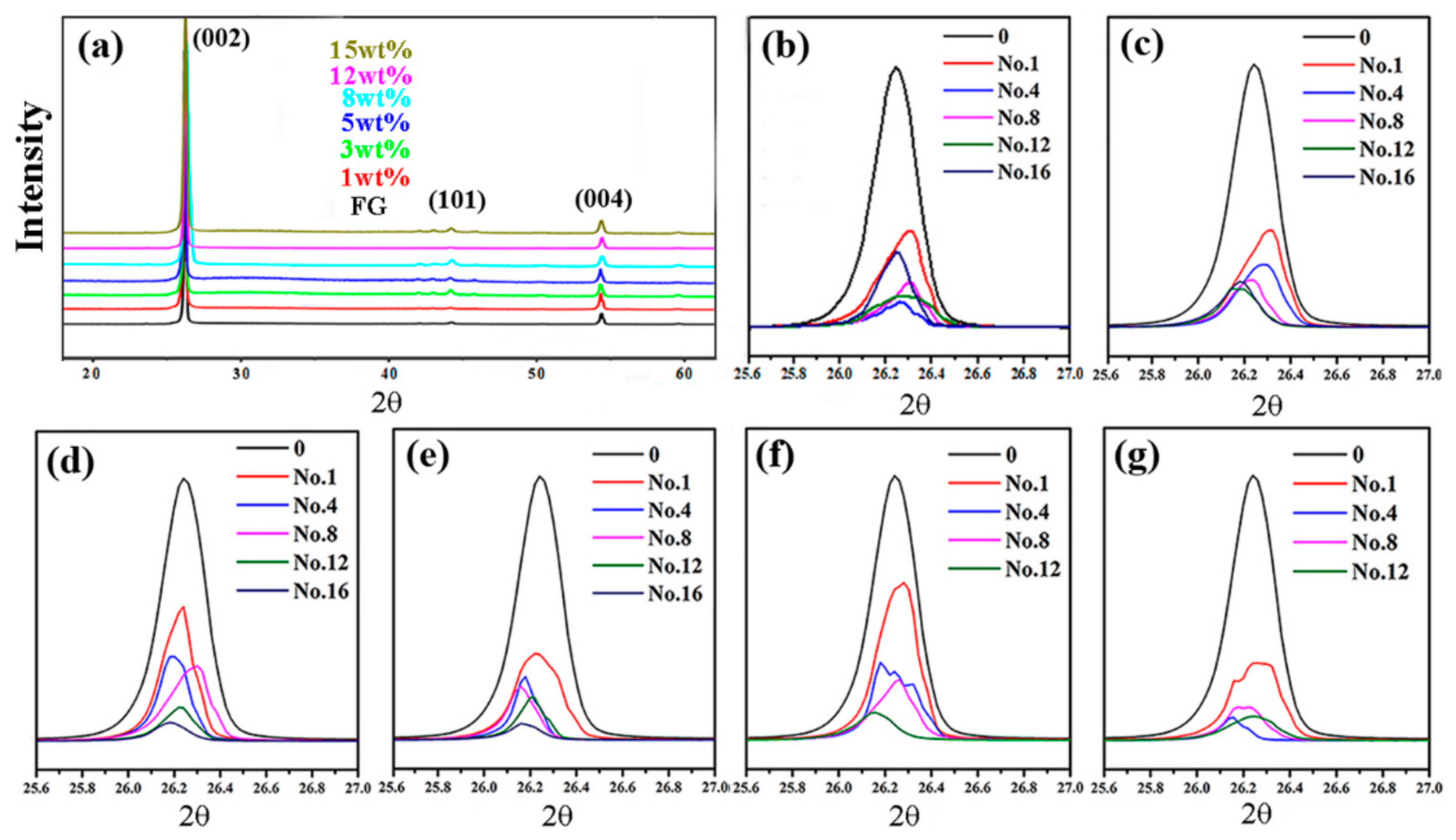
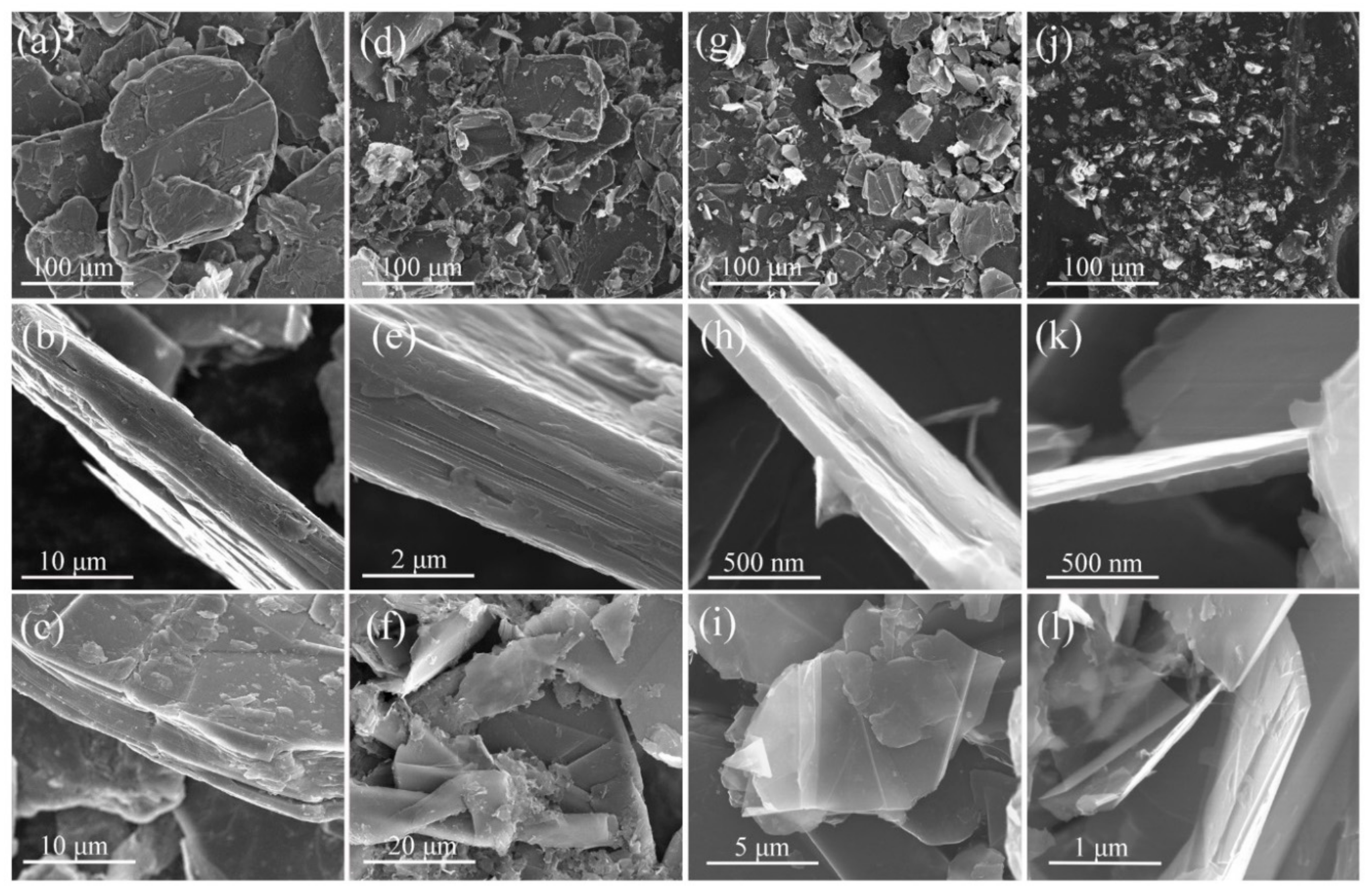
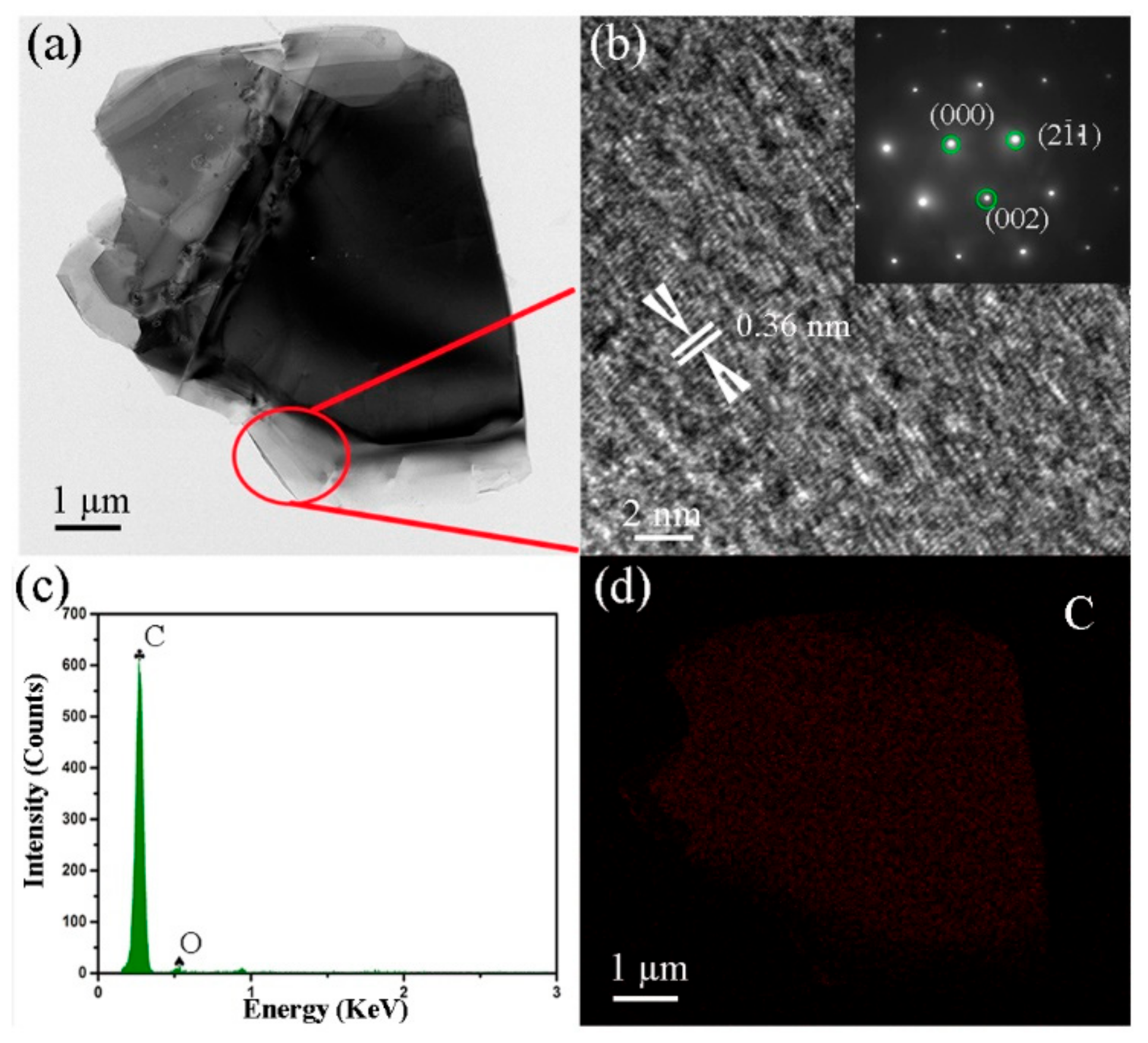

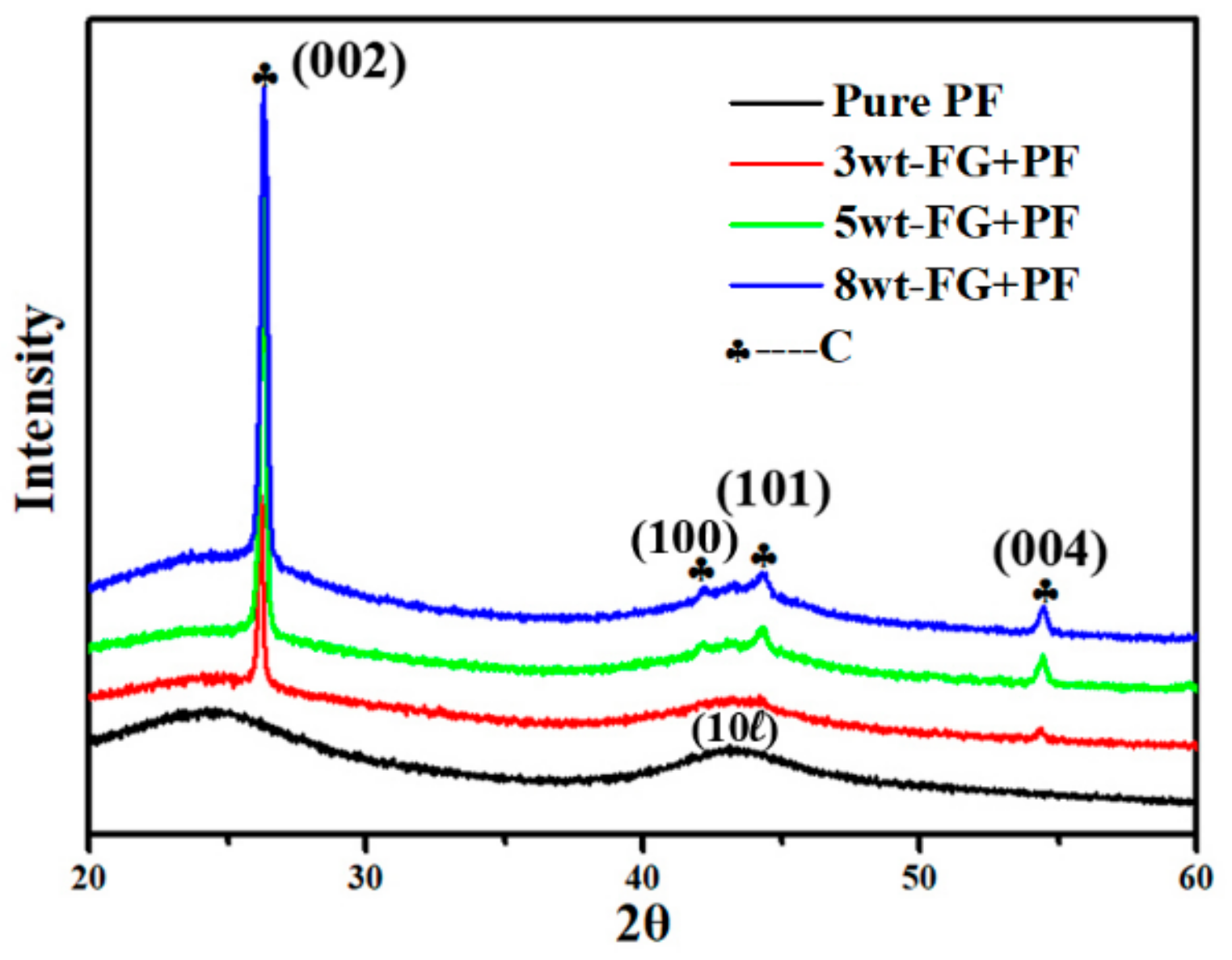
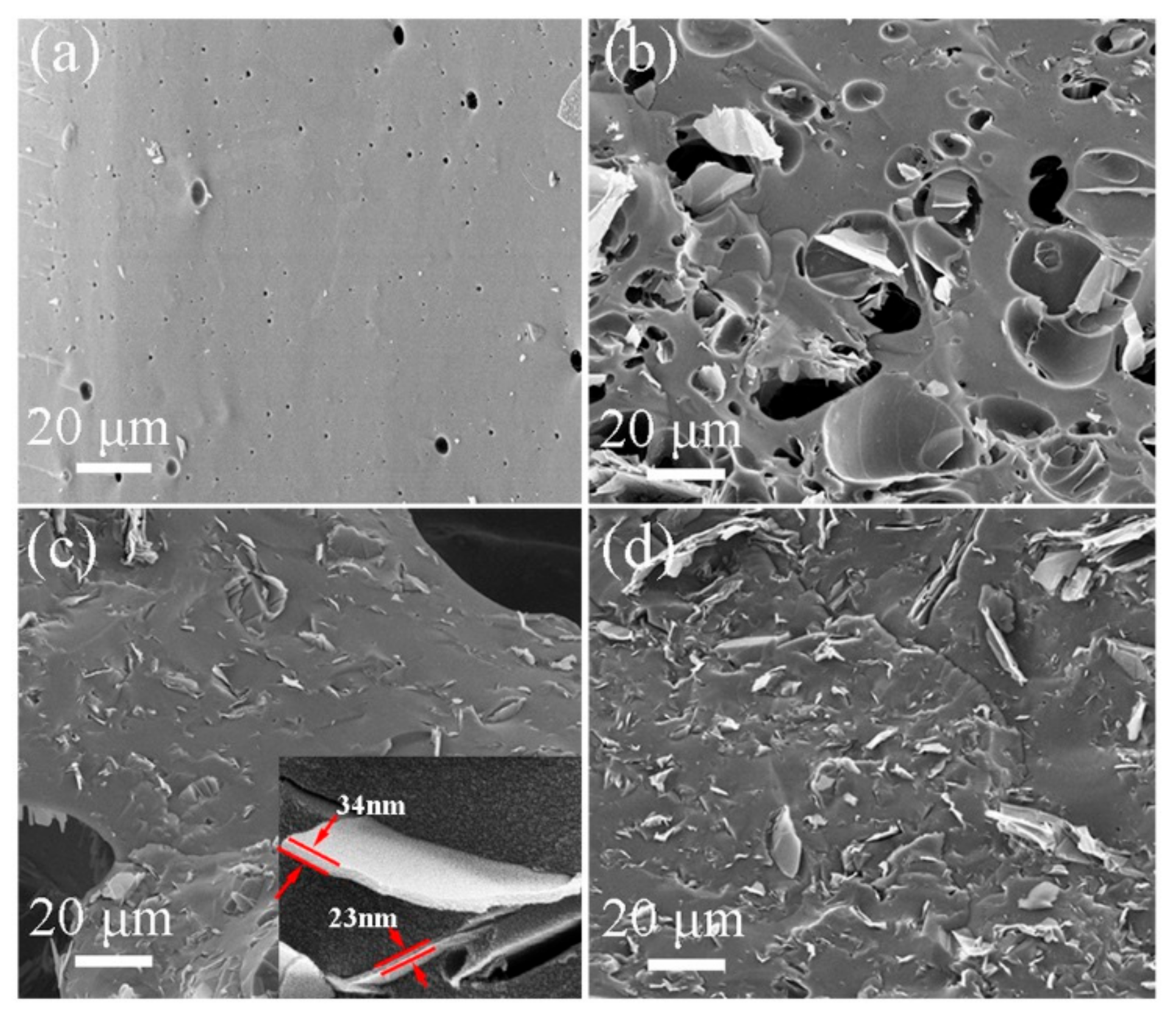

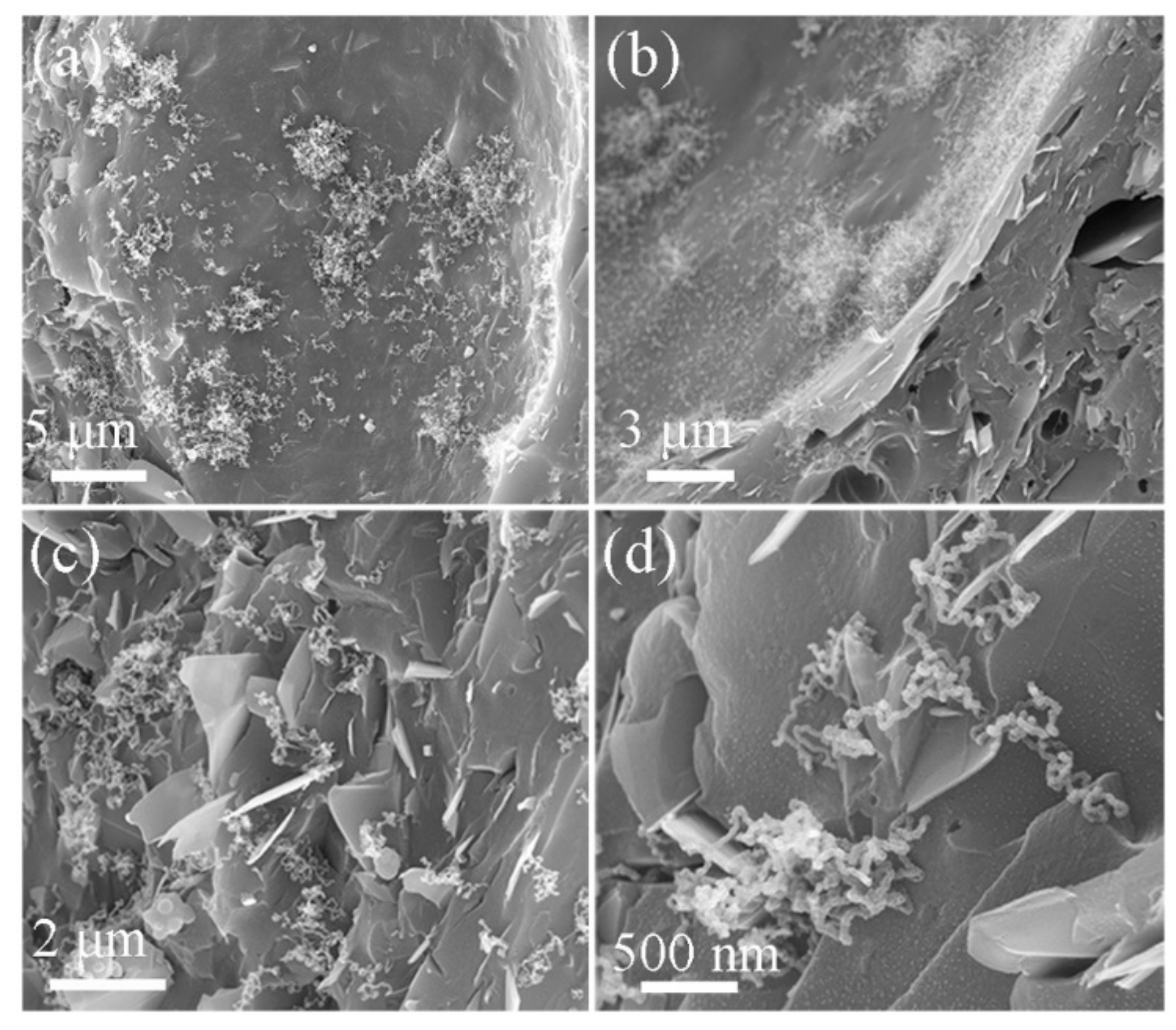
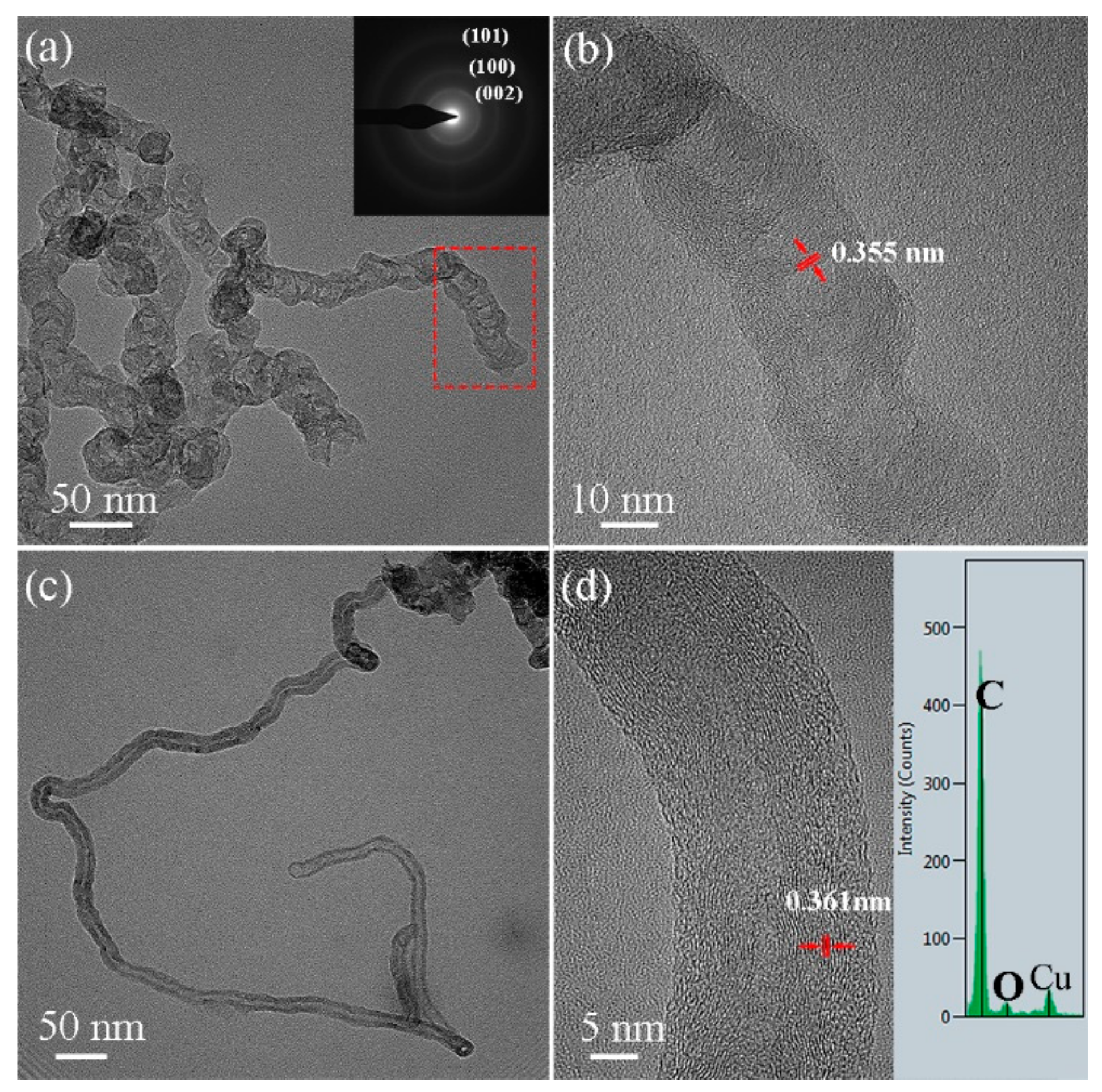

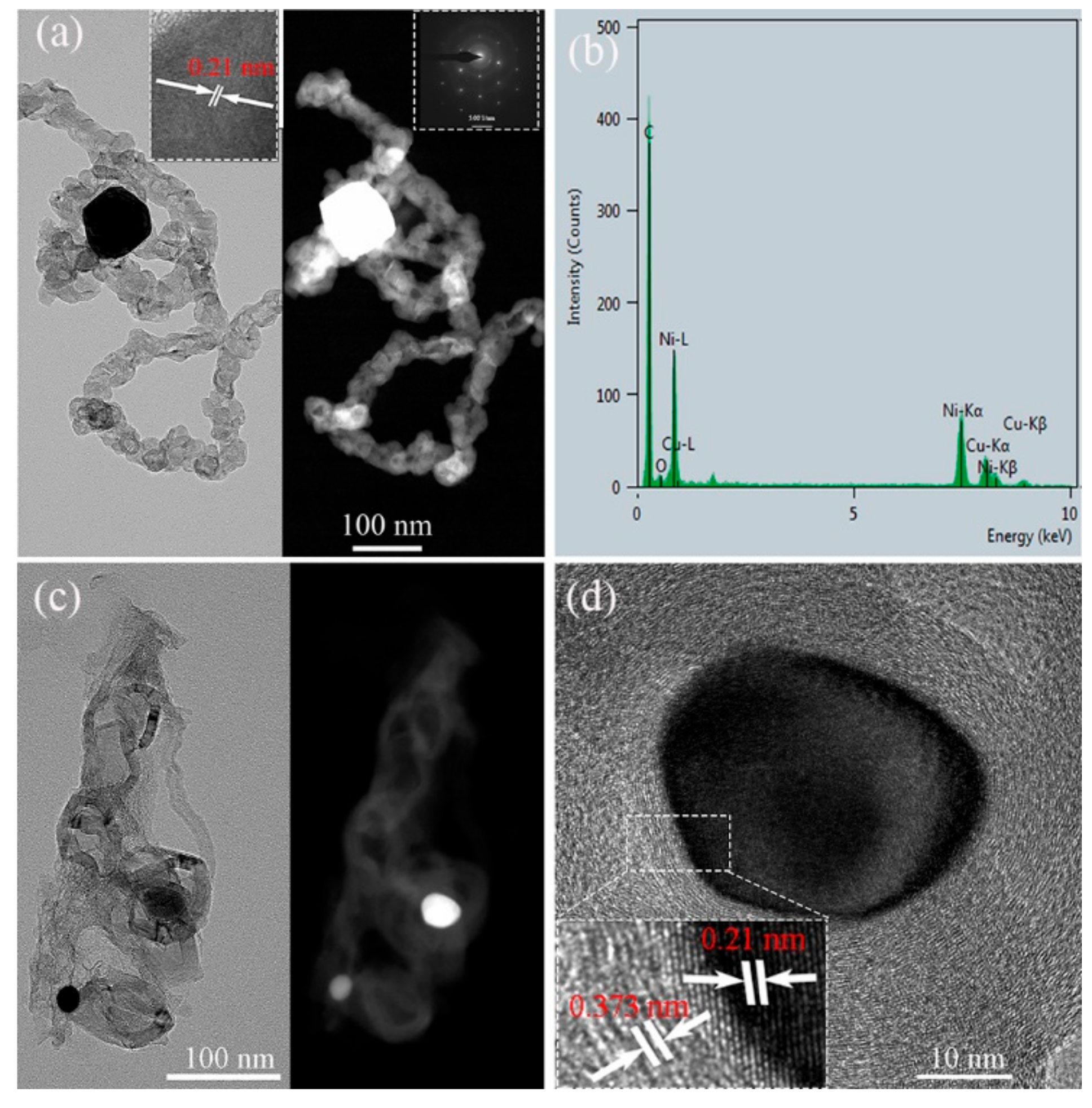

© 2019 by the authors. Licensee MDPI, Basel, Switzerland. This article is an open access article distributed under the terms and conditions of the Creative Commons Attribution (CC BY) license (http://creativecommons.org/licenses/by/4.0/).
Share and Cite
Liu, M.; Huang, J.; Xiong, Q.; Wang, S.; Chen, Z.; Li, X.; Liu, Q.; Zhang, S. Micro-Nano Carbon Structures with Platelet, Glassy and Tube-Like Morphologies. Nanomaterials 2019, 9, 1242. https://doi.org/10.3390/nano9091242
Liu M, Huang J, Xiong Q, Wang S, Chen Z, Li X, Liu Q, Zhang S. Micro-Nano Carbon Structures with Platelet, Glassy and Tube-Like Morphologies. Nanomaterials. 2019; 9(9):1242. https://doi.org/10.3390/nano9091242
Chicago/Turabian StyleLiu, Mingqiang, Juntong Huang, Qingming Xiong, Suqing Wang, Zhi Chen, Xibao Li, Qianwei Liu, and Shaowei Zhang. 2019. "Micro-Nano Carbon Structures with Platelet, Glassy and Tube-Like Morphologies" Nanomaterials 9, no. 9: 1242. https://doi.org/10.3390/nano9091242




